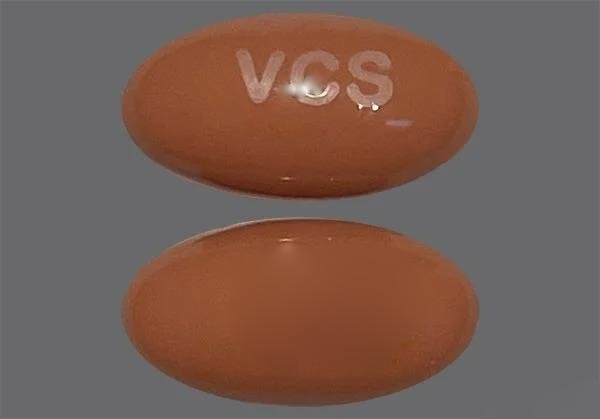Voclosporin Dosage
Medically reviewed by Drugs.com. Last updated on Jan 26, 2024.
Applies to the following strengths: 7.9 mg
Usual Adult Dose for:
Additional dosage information:
Usual Adult Dose for Lupus Nephritis
23.7 mg orally twice a day
Comments:
- The use of this drug in combination with cyclophosphamide is not recommended as safety and efficacy have not been established.
- Use this drug in combination with mycophenolate mofetil (MMF) and corticosteroids.
- Determine an actual baseline estimated glomerular filtration rate (eGFR) prior to initiating treatment.
- Dosage of this drug is based on the patient's eGFR and should be modified accordingly.
- Check blood pressure (BP) at baseline and do not initiate treatment in patients with BP greater than 165/105 mmHg or with hypertensive emergency.
- Treatment discontinuation should be considered if the patient does not experience therapeutic benefit by 24 weeks.
- Safety and efficacy have not been established beyond one year.
Use: In combination with a background immunosuppressive therapy regimen for the treatment of adult patients with active lupus nephritis
Renal Dose Adjustments
Mild or moderate renal dysfunction: No adjustment recommended.
Severe Renal Dysfunction (Estimated glomerular filtration rate 45 mL/min/1.73 m2 or less): Not recommended
- If used in Severe Renal Dysfunction at baseline the recommended starting dose is 15.8 mg twice a day.
Liver Dose Adjustments
Mild or moderate liver dysfunction (Child-Pugh A or B): 15.8 mg twice a day
Severe liver dysfunction (Child-Pugh C): Not recommended
Dose Adjustments
DOSAGE ADJUSTMENTS BASED ON ESTIMATED GLOMERULAR FILTRATION RATE (eGFR):
- If eGFR is less than 60 mL/min/1.73 m2 and reduced from baseline by more than 20% but less than 30%: Reduce dose by 7.9 mg twice a day
- Reassess eGFR within two weeks and if still reduced from baseline by more than 20%: Reduce dose again by 7.9 mg twice a day
- If eGFR is less than 60 mL/min/1.73 m2 and reduced from baseline by 30% or more: Discontinue treatment
- Reassess eGFR within two weeks and if eGFR has returned to 80% or more of baseline: Consider re-initiating treatment at 7.9 mg twice a day
- For patients that had a decrease in dose due to eGFR: Consider increasing the dose by 7.9 mg twice a day for each eGFR measurement that is 80% or more of baseline but do not exceed the starting dose
DOSAGE ADJUSTMENTS DUE TO DRUG INTERACTIONS:
- Coadministration with mild CYP450 3A4 inhibitors: No adjustment recommended
- Coadministration with moderate CYP450 3A4 inhibitors: Reduce the daily dosage to 15.8 mg in the morning and 7.9 mg in the evening
- Coadministration with strong CYP450 3A4 inhibitors: Contraindicated
- Coadministration with moderate or strong CYP450 3A4 inducers: Avoid use
Precautions
US BOXED WARNING:
MALIGNANCIES AND SERIOUS INFECTIONS:
- Patients treated with this drug or other immunosuppressants are at increased risk for developing serious infections and malignancies that may lead to hospitalization or death.
CONTRAINDICATIONS:
- Patients concomitantly using strong CYP450 3A inhibitors (e.g., ketoconazole, itraconazole, clarithromycin) because these medications can significantly increase exposure to this drug which may increase the risk of acute and/or chronic nephrotoxicity.
- Patients who have had a known serious or severe hypersensitivity reaction to this drug or any of its excipients.
Safety and efficacy have not been established in patients younger than 18 years.
Consult WARNINGS section for additional precautions.
Dialysis
Hemodialysis: Unknown
Other Comments
Administration Advice:
- Swallow capsules whole; do not open, crush, or divide
- Take capsules on an empty stomach as close to a 12-hour schedule with a minimum of 8 hours between the doses
- If a dose is missed, take it as soon as possible within 4 hours, wait until the next schedule dose if 4 hours have passed.
- Avoid eating or drinking grapefruit juice while taking this drug.
Storage Requirements:
- Store at controlled room temperature.
- Keep in the original packaging until ready to be used.
- Keep the product in the original container.
Monitoring:
- Monitor for electrolytes, including potassium levels periodically.
- Monitor for symptoms of neurotoxicity.
- Monitor for the development of infections.
- Monitor blood pressure for hypertension; obtain baseline blood pressure, then every two weeks for the first month, then as clinically indicated.
- Monitor renal function for nephrotoxicity; obtain baseline eGFR and monitor eGFR regularly during treatment.
- Monitor for QTc interval prolongation.
Patient Advice:
- Read the Patient Information Leaflet (Medication Guide).
- Advise patients to avoid eating grapefruit or drinking grapefruit juice while taking this drug.
- Advise patients to report symptoms of vision changes, delirium, or tremors as this can be signs of neurologic adverse effects.
- Advise patients that this drug may increase the risk of developing lymphomas and other malignancies, particularly of the skin.
- Advise patients to avoid artificial UV light, to wear protective clothing and use a broad-spectrum sunscreen with a high protection factor.
- Advise patients that this drug may increase their risk to infections.
- Advice patients to monitor their blood pressure as this drug can cause hypertension.
- Inform patients that this drug can have toxic effects on the kidney.
- Inform patients that this drug can cause hyperkalemia.
- Advise women not to breastfeed during treatment and for 7 days after the last dose.
- Advise patients that this drug can interfere with usual response to immunization and to avoid live vaccines.
More about voclosporin
- Check interactions
- Compare alternatives
- Side effects
- During pregnancy
- Drug class: calcineurin inhibitors
- Breastfeeding
- En español
Patient resources
Other brands
Professional resources
Other brands
Related treatment guides
Further information
Always consult your healthcare provider to ensure the information displayed on this page applies to your personal circumstances.


